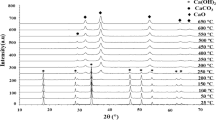Abstract
In this report, CuFe2O4 nanoparticles were synthesized using chemical co-precipitation method. The tetragonal phase formation of CuFe2O4 nanoparticles was confirmed by X-ray diffraction technique with its Rietveld refinement data, TEM and SEM analysis. The particle size of CuFe2O4 nanoparticles was found to be 6.4 ± 1 nm using Scherrer formula and TEM analysis. The surface morphology and porosity of CuFe2O4 nanoparticles and its sensing device were analysed using TEM, SEM and AFM images. The CuFe2O4 sensor was tested towards NH3, NO2, SO2 and smoke as change in conductance in terms of impedance spectroscopy with the help of electrochemical workstation. The performance of the sensor was investigated in the form of sensitivity, response and recovery time. The sensitivity was observed in the following order NH3 > NO2 > SO2 > smoke with response and recovery time 8 s and 5 min respectively.









Similar content being viewed by others
References
D. Rathore, R. Kurchania, R.K. Pandey, Structural, magnetic and dielectric properties of Ni1 – xZnxFe2O4 (x = 0, 0.5 and 1) nanoparticles synthesized by chemical co-precipitation method. J. Nanosci. Nanotechnol. 13, 1812–1819 (2013)
C.E. Rodrıguez, Torres et al., Oxygen-vacancy-induced local ferromagnetism as a driving mechanism in enhancing the magnetic response of ferrites. Phys. Rev. B 89, 104411 (2014)
C. Reitz, C. Suchomski, J. Haetge, T. Leichtweiss, Z. Jaglicic, I. Djerdj, T. Brezesinski, Soft-templating synthesis of mesoporous magnetic CuFe2O4 thin films with ordered 3D honeycomb structure and partially inverted nanocrystalline spinel domains. Chem. Commun. 48, 4471–4473 (2012)
S. Tao, F. Gao, X. Liu, O.T. Sørensen, Preparation and gas-sensing properties of CuFe2O4 at reduced temperature. Mater. Sci. Eng. B 77, 172–176 (2000)
T.G. Nenov, S.P. Yordanov, Ceramic Sensors, Technology and Application (CRC Press, Lancaster, 1996), pp. 20–42
J.U. Keller, R. Staudt, Gas Adsorption Equilibria: Experimental Methods and Adsorptive Isotherm (Springer, New York, 2006), pp. 17–52
K. Oura et al., Surface Science (Springer, Berlin, 2003), pp. 295–322
M.C. Desjonqueres, D. Spanjaard, Concept in Surface Physics, 2nd edn. (Springer, Berlin, 2012), pp. 162–267
S. Singh, B.C. Yadav, R. Prakash, B. Bajaj, J.R. Lee, Synthesis of nanorods and mixed shaped copper ferrite and their applications as liquefied petroleum gas sensor. Appl. Surf. Sci. 257, 10763–10770 (2011)
Z. Shahnavaz, F. Lorestani, W.P. Meng, Y. Alias, Core-shell–CuFe2O4/PPy nanocomposite enzyme-free sensor for detection of glucose. J. Solid State Electrochem. (2015). doi:10.1007/s10008-015-2738-6
P. Srivastava, A. Garg, Emissions from forest fires in India—as assessment based on MODIS fire and global land cover products. Clim. Change Environ. Sustain. 1, 138–144 (2013)
Z. Sun, L. Liu, D.Z. Jia, W. Pan,; Simple synthesis of CuFe2O4 nanoparticles as gas-sensing materials. Sens. Actuators B. 125, 144–148 (2007)
J.L. Martinez Hurtado, C.R. Lowe, Ammonia-sensitive photonic structures fabricated in nafion membranes by laser ablation. Appl. Mater. Interfaces. 6, 8903–8908 (2014)
B.D. Cullity, Elements of X-ray Diffraction, 2nd edn. (Addison Wesley, Morris Cohen, 1956), pp. 284–287
R. Kurchania, D. Rathore, R.K. Pandey, Size dependent strain and nanomagnetism in CoFe2O4 nanoparticles. J Mater. Sci. 26, 9355–9365 (2015)
B. Timmer, W. Olthuis, A.V.D. Berg, Ammonia sensors and their applications—a review. Sens. Actuators B 107, 666–677 (2005)
D. Rathore, R. Kurchania, R.K. Pandey, Fabrication of Ni1 – xZnxFe2O4 (x = 0, 0.5 and 1) nanoparticles gas sensor for some reducing gases. Sens. Actuators A 199, 236–240 (2013)
D. Rathore, R. Kurchania, R.K. Pandey, Gas sensing properties of size varying CoFe2O4 nanoparticles. IEEE Sens. 15, 4961–4966 (2015)
D. Rathore, R. Kurchania, R.K. Pandey, Influence of particle size and temperature on the dielectric properties of CoFe2O4 nanoparticles. Int. J. Min. Metall. Mater. 21, 408–412 (2014)
M.A.L. Nobre, S. Lanfredi, Phase transition in sodium lithium niobate polycrystal: an overview based on impedance spectroscopy. J. Phys. Chem. Solids 62, 1999–2006 (2001)
S. Lanfredi, P.S. Saia, R. Lebullenger, A.C. Hernandes, Electric conductivity and relaxation in fluoride, fluorophosphates and phosphate glasses: analysis by impedance spectroscopy. Solid State Ion. 146, 329–339 (2002)
K.P. Padmasree, D.K. Kanchan, A.k Kulkarni, Impedance and modulus studies of the solid electrolyte system 20CdI2–80[xAg2O–y(0.7V2O5–0.3B2O3)], where 1 ≤ x/y ≤ 3. Solid State Ion. 177, 475–482 (2006)
R.J. Grant, M.D. Ingram, L.D.S. Turner, C.A. Vincent, Optimized ionic conductivity in glass. Vitreous silver arsenate iodide (Ag7I4AsO4) electrolytes. J. Phys. Chem. 82, 2838–2844 (1978)
A.K. Jonscher, Analysis of the alternating current properties of ionic conductors., J. Mater. Sci. 13, 553–562 (1978)
P. Shankar, J.B.B. Rayappan, Gas sensing mechanism of metal oxides: the role of ambient atmosphere, type of semiconductor and gases—a review. Sci. Jet 4, 126 (2015)
C.N. Hussain, B. Kharisov, Advanced Environmental Analysis: Applications of Nanomaterials, vol. 2 (Royal Society of Chemistry, Cambridge, 2016), pp. 56–57
Author information
Authors and Affiliations
Corresponding author
Rights and permissions
About this article
Cite this article
Rathore, D., Mitra, S., Kurchania, R. et al. Physicochemical properties of CuFe2O4 nanoparticles as a gas sensor. J Mater Sci: Mater Electron 29, 1925–1932 (2018). https://doi.org/10.1007/s10854-017-8102-0
Received:
Accepted:
Published:
Issue Date:
DOI: https://doi.org/10.1007/s10854-017-8102-0




